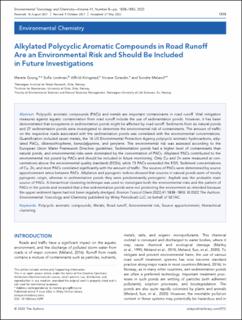| dc.contributor.author | Grung, Merete | |
| dc.contributor.author | Lindman, Sofie Jenny | |
| dc.contributor.author | Kringstad, Alfhild | |
| dc.contributor.author | Girardin, Viviane | |
| dc.contributor.author | Meland, Sondre | |
| dc.date.accessioned | 2023-04-04T09:26:30Z | |
| dc.date.available | 2023-04-04T09:26:30Z | |
| dc.date.created | 2022-08-22T09:54:44Z | |
| dc.date.issued | 2022 | |
| dc.identifier.citation | Environmental Toxicology and Chemistry. 2022, 41 (8), 1838-1850. | |
| dc.identifier.issn | 0730-7268 | |
| dc.identifier.uri | https://hdl.handle.net/11250/3062015 | |
| dc.description.abstract | Polycyclic aromatic compounds (PACs) and metals are important contaminants in road runoff. Vital mitigation measures against aquatic contamination from road runoff include the use of sedimentation ponds. However, it has been demonstrated that ecosystems in sedimentation ponds might be affected by road runoff. Sediments from six natural ponds and 27 sedimentation ponds were investigated to determine the environmental risk of contaminants. The amount of traffic on the respective roads associated with the sedimentation ponds was correlated with the environmental concentrations. Quantification included seven metals, the 16 US Environmental Protection Agency polycyclic aromatic hydrocarbons, alkylated PACs, dibenzothiophene, benzo[e]pyrene, and perylene. The environmental risk was assessed according to the European Union Water Framework Directive guidelines. Sedimentation ponds had a higher level of contaminants than natural ponds, and environmental risks were dominated by the concentration of PACs. Alkylated PACs contributed to the environmental risk posed by PACs and should be included in future monitoring. Only Cu and Zn were measured at concentrations above the environmental quality standards (EQSs), while 13 PACs exceeded the EQS. Sediment concentrations of Cu, Zn, and most PACs correlated significantly with the amount of traffic. The sources of PACs were determined by source apportionment ratios between PACs. Alkylation and pyrogenic indices showed that sources in natural ponds were of mostly pyrogenic origin, whereas in sedimentation ponds they were predominantly petrogenic. Asphalt was the probable main source of PACs. A hierarchical clustering technique was used to investigate both the environmental risks and the pattern of PACs in the ponds and revealed that a few sedimentation ponds were not protecting the environment as intended because the upper sediment layers had not been regularly dredged. | |
| dc.language.iso | eng | |
| dc.title | Alkylated Polycyclic Aromatic Compounds in Road Runoff Are an Environmental Risk and Should Be Included in Future Investigations | |
| dc.title.alternative | Alkylated Polycyclic Aromatic Compounds in Road Runoff Are an Environmental Risk and Should Be Included in Future Investigations | |
| dc.type | Peer reviewed | |
| dc.type | Journal article | |
| dc.description.version | publishedVersion | |
| dc.description.version | publishedVersion | |
| dc.source.pagenumber | 1838-1850 | |
| dc.source.volume | 41 | |
| dc.source.journal | Environmental Toxicology and Chemistry | |
| dc.source.issue | 8 | |
| dc.identifier.doi | 10.1002/etc.5399 | |
| dc.identifier.cristin | 2044818 | |
| dc.relation.project | Norges forskningsråd: 160016 | |
| cristin.ispublished | true | |
| cristin.fulltext | original | |
| cristin.fulltext | original | |
| cristin.qualitycode | 2 | |
